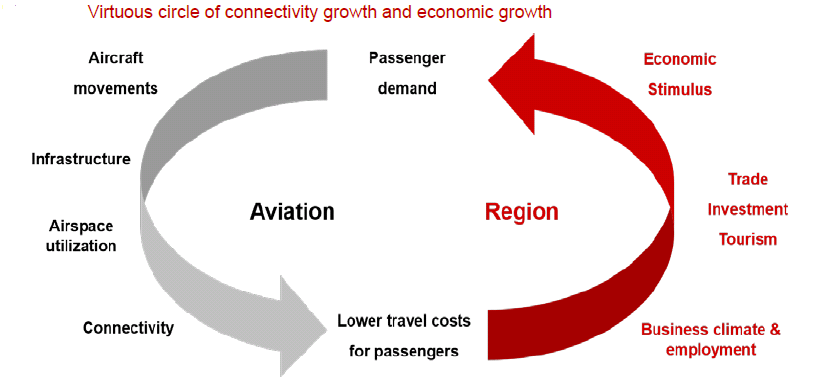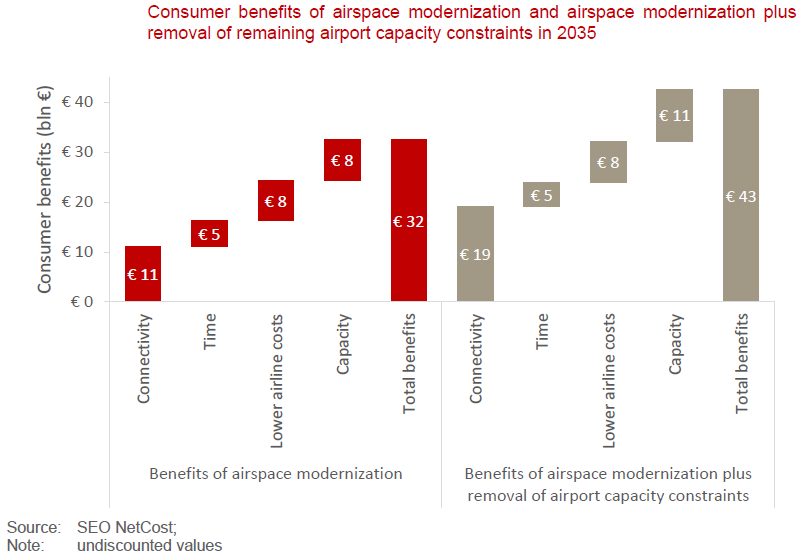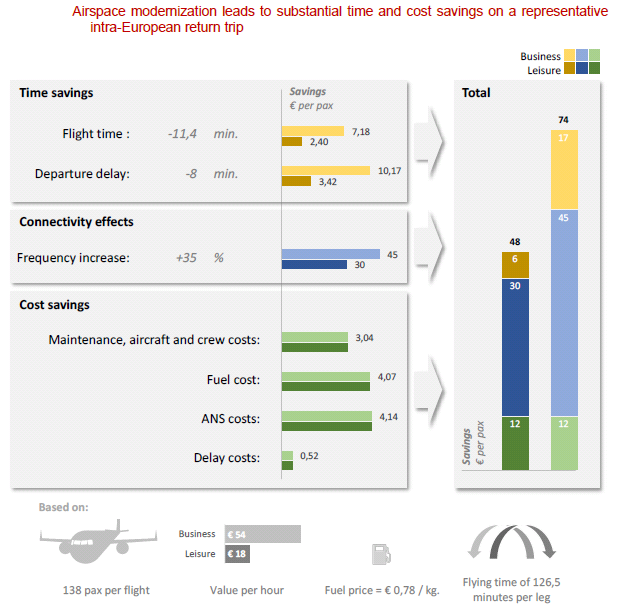Leeham News and Analysis
There's more to real news than a news release.
Bjorn’s Corner: SES, Single European Sky
June 10, 2016, ©. Leeham Co: Last week I wrote about the practical implementation of the next generation Air Traffic Management (ATM) that is possible with the new technology based on ADS-B transponders. My examples were from the implementation of the US NextGen Air Traffic Management.
The US has the advantage that the airspace has one Air Navigation Service Provider (ANSP), i.e. one organization for the Air Traffic Controllers. We will now look at the next generation Air Traffic Management in Europe where the project is called SES, Single European Sky. I wrote about SESAR, Single European Sky ATM Research, last week. This is the technology project for implementing ADS-B based ATM, SES is the European Union initiative involving all ANSPs in Europe in the change process.
Presently Europe is divided into 37 ANSPs (the US airspace has one). The ANSPs operate within the national borders of the European states, each serving its own country. SES has proposed to change the present 37 Functional Airspace Blocks (FABs) to 9, Figure 1
Air space controllers rejecting change process
The changing of the airspace to the one in Figure 1 and the organisation of the national ANSPs into larger ones each controlling its FAB has run into problems. The unions organizing the people working in the 37 ANSPs (17,000 Air Traffic Controllers controlling 30,000 flights a day) said the proposal for the changes “is based on market principles and is a top-down approach and focus cost reductions. It would jeopardize safety and the number and quality of jobs.”
As we saw with the NextGen pilots for the US airspace, the implementation of a more modern and rational European Airspace is a process where the people and organizational component is the more challenging one, not the technical implementation.
To date, very little progress has been made to the Single European Sky and the new Functional Airspace Blocks. We remain with the national organizations and changes results in strike actions from the affected Air Traffic Controllers.
IATA gets involved
To help the SES project to find the motivation for change, the association for all airlines affected by the present state, IATA, commissioned an independent report to quantify what’s involved in the change or no change.
The research has been done by the established institute SEO Amsterdam Economics which is a non-profit organization connected to the Amsterdam University.
SEO found that that air transportation is intrinsically interlinked with economic growth in a virtuous circle, Figure 2.
SEO summarized their findings of change versus no change in the left part of Figure 3. The right part includes fixing of the airport constraints that are starting to appear.
The report states:
Airspace modernization could deliver European consumers an additional €32 billion of welfare benefits in the year 2035, compared to a ‘do nothing.’ The total present value of airspace modernization over the 2015-2035 period cumulates to €126 billion. These benefits consist of:
- More efficient air navigation services provision at a higher capacity, which translates into airline cost savings and lower air fares;
- Time and reliability savings: travel times are shorter because routings will be more direct.
Passengers and airlines will face fewer delays;
- Average flight times will be reduced with 4-8 minutes per one-way flight, while average delays decrease from 12 to 8 minutes per flight, in comparison to a ‘do nothing’ scenario;
- Connectivity growth (more routes, more frequencies);
- Wider economic benefits caused by agglomeration effects and higher productivity levels;
- Lower CO2 emissions per flight.
IATA was surprised by the figures and scrutinized the study. It found that SEO had been using conservative estimation methods.
Why would the gains be so large for European citizens? Presently there are a lot of extra distances flown and delays resulting in increased fuel burn and emission of CO2 (directly linked to fuel burn).
The report exemplifies the effects with on typical two hour flight within Europe, Figure 4. As can be seen, the total costs savings which would be directly seen in the consumer ticket price would be 74€ for the business traveler and 48€ for the leisure traveler.
Way forward
The IATA study has quantified for the European politicians what’s at stake. It’s now up to EU and the country organizations to drive the change process so that changes in European Air Traffic Management can move forward a needed pace.







Good luck getting that one past the notoriously feisty French unions,who have been on strike more than 50 times in the last 7 years.
Your posting date appears wrong.
Fixed. Thanks.
Some European labor unions love to strike and screw up things for everybody else. In the US, those working at FAA controlled ATCs don’t have the right to strike, and they should not. As I recall, President Reagan fired 11,ooo controllers for striking illegally, replaced them with military controllers and life went on. Europe is much smaller than the US so why can’t they have a single ATC????This is not rocket science.
I agree Andy, the 9 FABs you see with 9 ANSPs is a compromise from the second revised SES plan, haven’t found how it was in the first plan yet. Europe is made up of many countries with their cultures and ruling systems. At the same time as that make life here rich (each country is so different) it also frustrates. The French relation between unions and employer is particular contentions since way back. The country had someone that could control this in De Gaulle but not since. 60% of the french think the present strikes by AF pilots and railway personnel which sabotages the European soccer championship is OK, then it is difficult to motivate change in a democratic country (the strikes are about changes to the employment laws making hire and fire a little easier and the central negotiations a bit less important).
Re European airspace being much smaller, not really but inefficiently managed because of history, it is not one state;

Bjorn, thanks. Seems like the IATA table reflects the geographical Europe and not the much smaller EU, so I would expect that the EU numbers look even worse in terms of cost/Flight/FH/km. It is sad that the EU has become a bureaucratic failure where open borders now contribute to the destruction of cultures. Failure to implement a single ATC is an indication that the EU member countries have a problem with the EU concept. It is not surprising that some countries refused to join EU and that the UK now wants to get out of it. It is not only the French who strike. SAS Swedish pilots are on strike now, and the 100+ wildcat strikes in CPH will never be forgotten by those who were affected several times. Makes you wonder about work ethics, doesn’t it?
Andy, I’m guessing that you’re a proud second.I have just looked up days lost due to strike action per country. It seems to be very difficult to get consistent numbers, but the surprising fact is the USA is somewhere in the middle of the EU countries! Remember the damage done to Boeing and the longshore men on the west coast
Second -supposed to be sepo, slang for yank
grubbie, it is difficult to get consistent numbers, and the only way to compare “propensity for labor strikes” fairly is to also take into account the number of companies. Just comparing raw strike numbers don’t mean much. About half of the states in the USA are “right to work” where people can not be forced to join labor unions. It is interesting to note that the majority of foreign car manufacturers have established plants in those states, as has Airbus, and also Boeing. You are absolutely correct about the longshoremen and Boeing labor strikes in Washington, which is not a “right to work” state.
In my opinion, strikes that negatively affect millions of people or endanger public safety, such as striking by ATC, police, fire department, military, health care, should be illegal.
Interessting to see that the big difference here in the numbers are the “Total Staff”!! In EU we have 50% more than USA with similar area and less flights!! Think about the burocracy that every ANSP has to deal with to respect all the EU paramenters. I think that instead of focusing on operational people, who instead make great job and has improve incredibly the efficiency of traffc, decreasing the rates. We should look at an unique center of burocracy which should leading the administrative part of the business. We probably have thousand of “same jobs” in the various ANSP, which could be bring together in one or two places in the continent.
I thought this was oriented towards ATC?
And I seem to recall the US and budge shutdowns as well as a Leader of the Senate whose goal was to make the current American Presidents tenure one term?
The American constitution instituted slavery as a compromise to bring 13 fractious nations together.
I don’t know we could have what could be called euphemistically two hugely different valued cultures being brought into the same association
The current republican presumptive nominee?
Easy to point fingers.
Etu Brutai?